Abstract
Incubation of spinach chloroplast membranes for 90 minutes in the presence of 50 mm KCN and 100 μm HgCl2 produces an inhibition of photosystem I activity which is stable to washing and to storage of the chloroplasts at −70 C. Subsequent exposure of these preparations to NH2OH and ethylenediaminetetraacetic acid destroys O2 evolution and flow of electrons from water to oxidized p-phenylenediamine, but two types of phosphorylating cyclic electron flow can still be observed. In the presence of 3-(3,4-dichlorophenyl)-1,1′-dimethylurea, phenazinemethosulfate catalyzes ATP synthesis at a rate 60% that observed in uninhibited chloroplasts. C-Substituted p-phenylenediamines will also support low rates of photosystem I-catalyzed cyclic photophosphorylation, but p-phenylenediamine is completely inactive. When photosystem II is not inhibited, p-phenylenediamine will catalyze ATP synthesis at rates up to 90 μmol/hr·mg chlorophyll. This reaction is unaffected by anaerobiosis, and an action spectrum for ATP synthesis shows a peak at 640 nm. These results are interpreted as evidence for the existence of photosystem II-dependent cyclic photophosphorylation in these chloroplast preparations.
Full text
PDF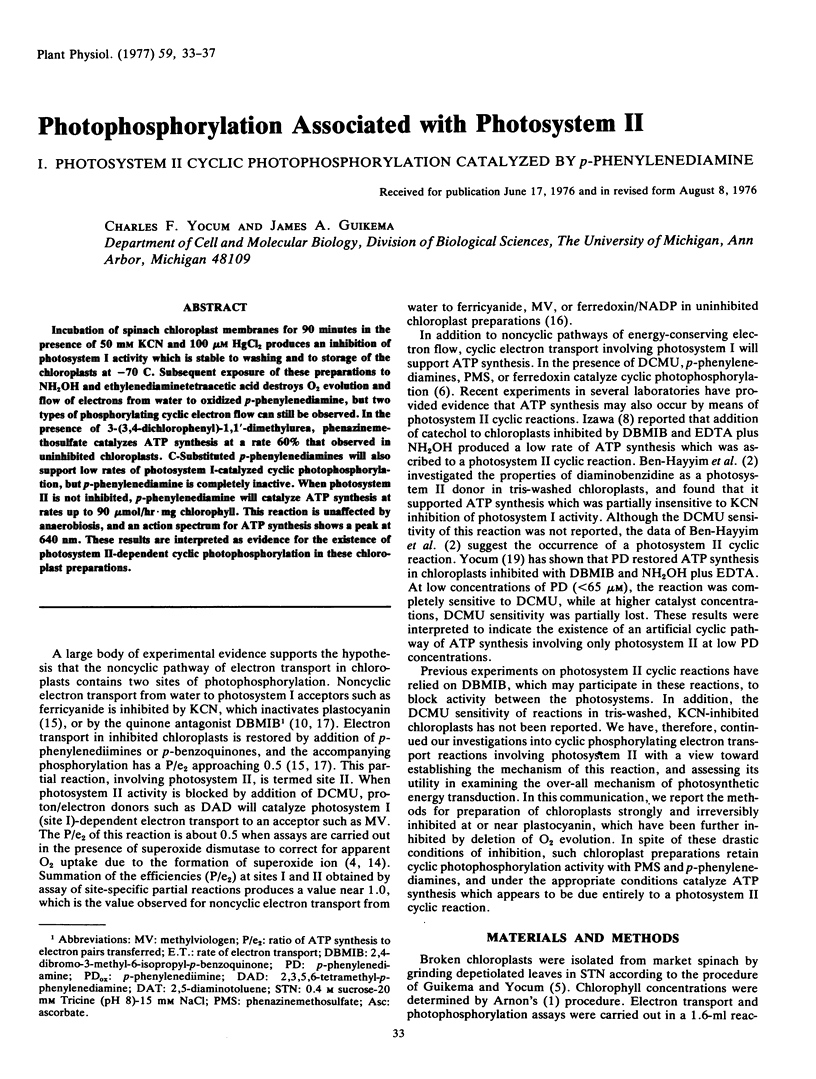
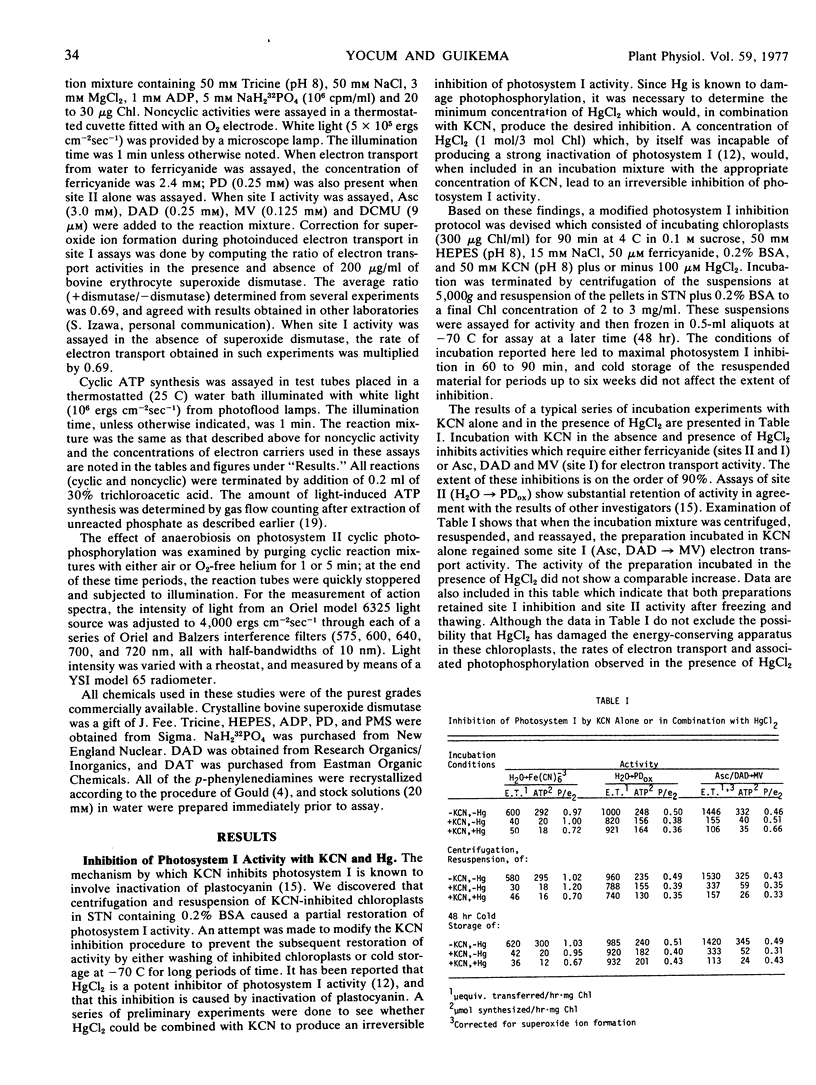
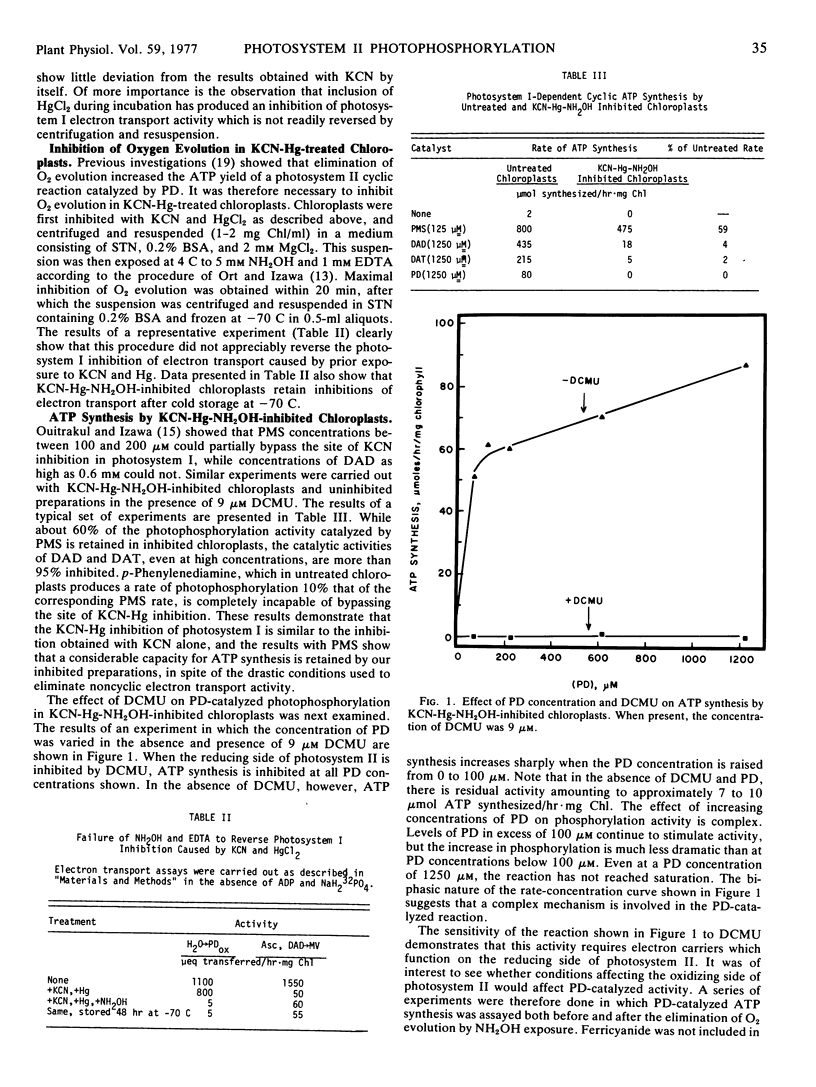
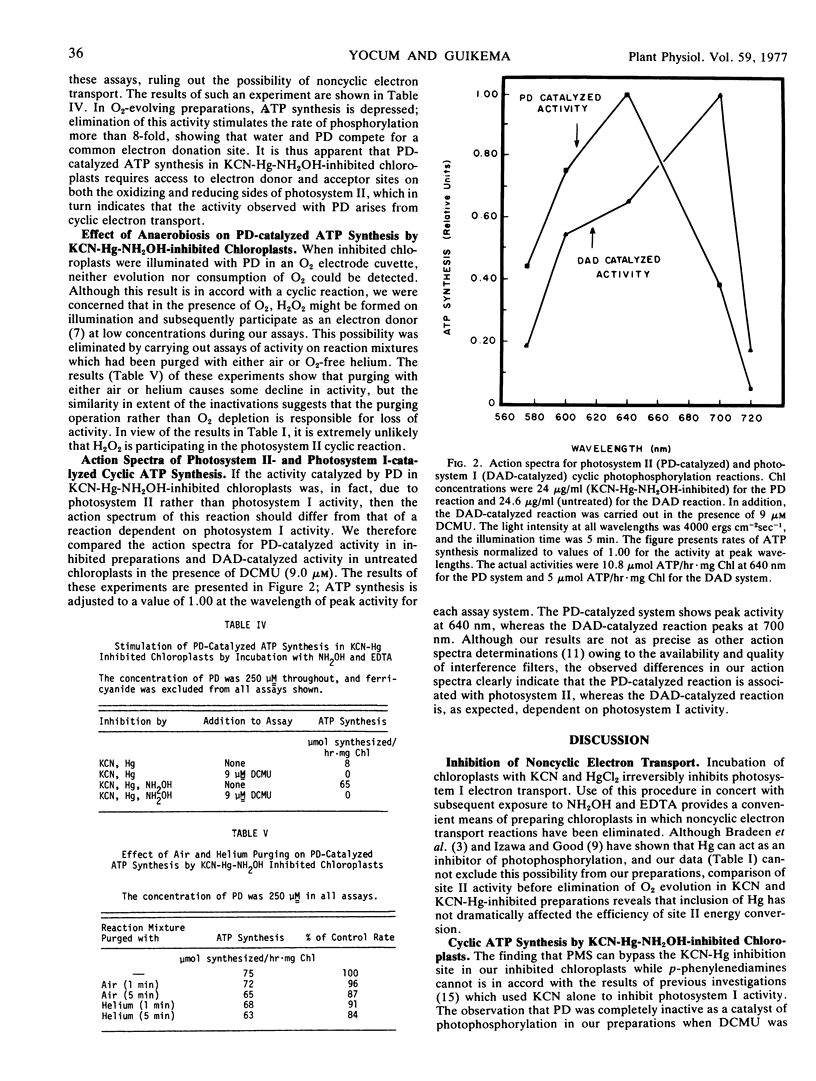
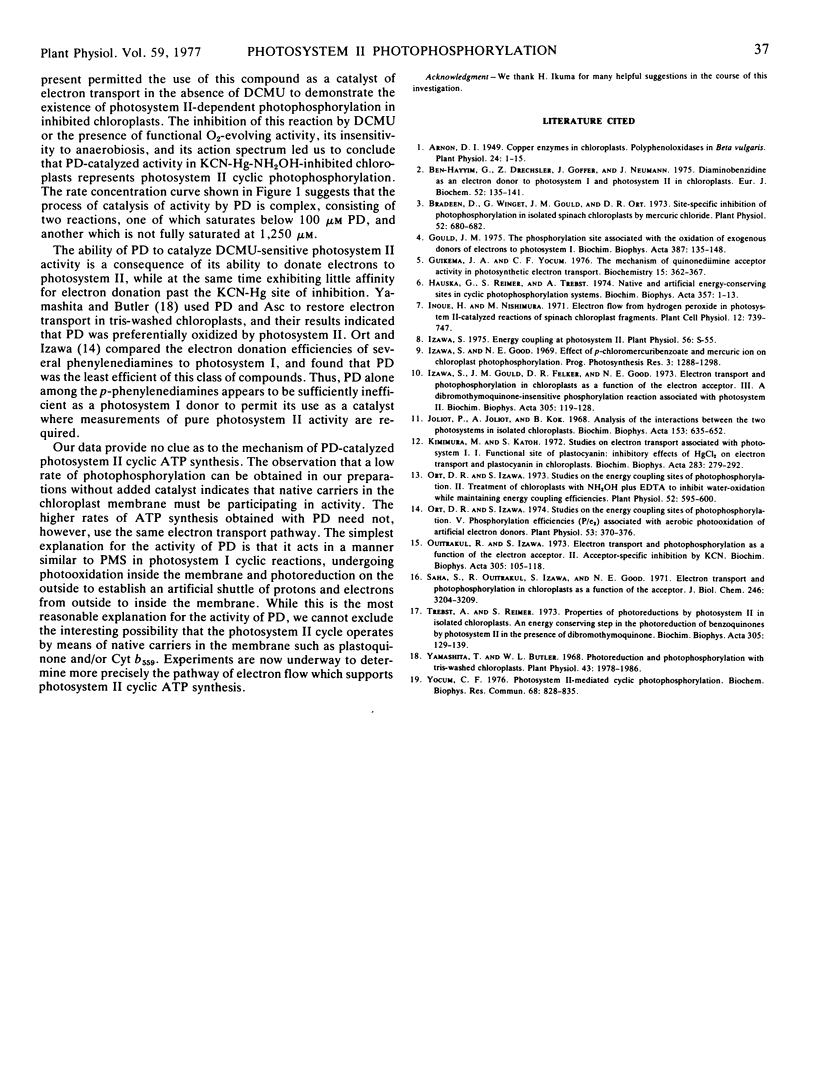
Selected References
These references are in PubMed. This may not be the complete list of references from this article.
- Arnon D. I. COPPER ENZYMES IN ISOLATED CHLOROPLASTS. POLYPHENOLOXIDASE IN BETA VULGARIS. Plant Physiol. 1949 Jan;24(1):1–15. doi: 10.1104/pp.24.1.1. [DOI] [PMC free article] [PubMed] [Google Scholar]
- Ben-Hayyim G., Drechsler Z., Goffer J., Neumann J. Diaminobenzidine an electron donor to photosystem 1 and to photosystem 2 in chloroplasts. Eur J Biochem. 1975 Mar 3;52(1):135–141. doi: 10.1111/j.1432-1033.1975.tb03981.x. [DOI] [PubMed] [Google Scholar]
- Bradeen D. A., Winget G. D. Site-specific Inhibition of Photophosphorylation in Isolated Spinach Chloroplasts by Mercuric Chloride. Plant Physiol. 1973 Dec;52(6):680–682. doi: 10.1104/pp.52.6.680. [DOI] [PMC free article] [PubMed] [Google Scholar]
- Gould J. M. The phosphorylation site associated with the oxidation of exogenous donors of electrons to photosystem I. Biochim Biophys Acta. 1975 Apr 14;387(1):135–148. doi: 10.1016/0005-2728(75)90058-4. [DOI] [PubMed] [Google Scholar]
- Guikema J. A., Yocum C. F. The mechanism of quinonediimine acceptor activity in photosynthetic electron transport. Biochemistry. 1976 Jan 27;15(2):362–367. doi: 10.1021/bi00647a019. [DOI] [PubMed] [Google Scholar]
- Hauska G., Reimer S., Trebst A. Native and artificial energy-conserving sites in cyclic photophosphorylation systems. Biochim Biophys Acta. 1974 Jul 25;357(1):1–13. doi: 10.1016/0005-2728(74)90106-6. [DOI] [PubMed] [Google Scholar]
- Izawa S., Gould J. M., Ort D. R., Felker P., Good N. E. Electron transport and photophosphorylation in chloroplasts as a function of the electron acceptor. 3. A dibromothymoquinone-insensitive phosphorylation reaction associated with photosystem II. Biochim Biophys Acta. 1973 Apr 27;305(1):119–128. doi: 10.1016/0005-2728(73)90237-5. [DOI] [PubMed] [Google Scholar]
- Joliot P., Joliot A., Kok B. Analysis of the interactions between the two photosystems in isolated chloroplasts. Biochim Biophys Acta. 1968 Apr 2;153(3):635–652. doi: 10.1016/0005-2728(68)90191-6. [DOI] [PubMed] [Google Scholar]
- Kimimura M., Kato S. Studies on electron transport associated with photosystem I. I. Functional site of plastocyanin: inhibitory effects of HgCl 2 on electron transport and plastocyanin in chloroplasts. Biochim Biophys Acta. 1972 Nov 17;283(2):279–292. doi: 10.1016/0005-2728(72)90244-7. [DOI] [PubMed] [Google Scholar]
- Ort D. R., Izawa S. Studies on the Energy-coupling Sites of Photophosphorylation: II. Treatment of Chloroplasts with NH(2)OH Plus Ethylenediaminetetraacetate to Inhibit Water Oxidation while Maintaining Energy-coupling Efficiencies. Plant Physiol. 1973 Dec;52(6):595–600. doi: 10.1104/pp.52.6.595. [DOI] [PMC free article] [PubMed] [Google Scholar]
- Ort D. R., Izawa S. Studies on the Energy-coupling Sites of Photophosphorylation: V. Phosphorylation Efficiencies (P/e(2)) Associated with Aerobic Photooxidation of Artificial Electron Donors. Plant Physiol. 1974 Mar;53(3):370–376. doi: 10.1104/pp.53.3.370. [DOI] [PMC free article] [PubMed] [Google Scholar]
- Ouitrakul R., Izawa S. Electron transport and photophosphorylation in chloroplasts as a function of the electron acceptor. II. Acceptor-specific inhibition by KCN. Biochim Biophys Acta. 1973 Apr 27;305(1):105–118. doi: 10.1016/0005-2728(73)90236-3. [DOI] [PubMed] [Google Scholar]
- Saha S., Ouitrakul R., Izawa S., Good N. E. Electron transport and photophosphorylation in chloroplasts as a function of the electron acceptor. J Biol Chem. 1971 May 25;246(10):3204–3209. [PubMed] [Google Scholar]
- Trebst A., Reimer S. Properties of photoreductions by photosystem II in isolated chloroplasts. An energy-conserving step in the photoreduction of benzoquinones by photosystem II in the presence of dibromothymoquinone. Biochim Biophys Acta. 1973 Apr 27;305(1):129–139. doi: 10.1016/0005-2728(73)90238-7. [DOI] [PubMed] [Google Scholar]
- Yamashita T., Butler W. L. Photoreduction and photophosphorylation with tris-washed chloroplasts. Plant Physiol. 1968 Dec;43(12):1978–1986. doi: 10.1104/pp.43.12.1978. [DOI] [PMC free article] [PubMed] [Google Scholar]
- Yocum C. F. Photosystem II - mediated cyclic photophosphorylation. Biochem Biophys Res Commun. 1976 Feb 9;68(3):828–835. doi: 10.1016/0006-291x(76)91220-1. [DOI] [PubMed] [Google Scholar]


